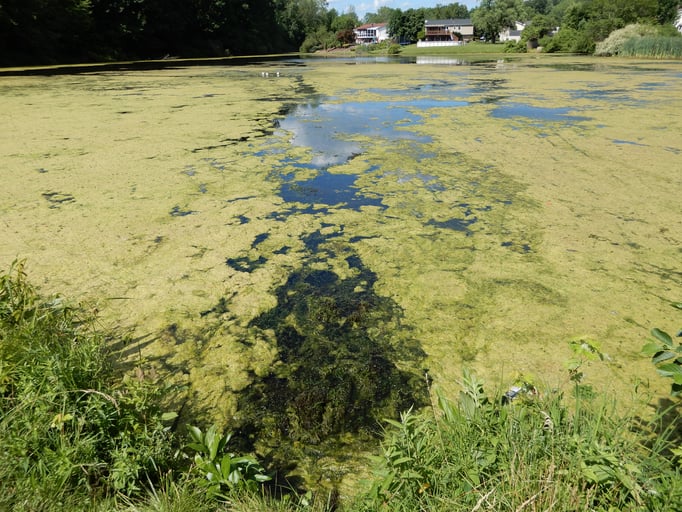Posted on Mar 13, 2025
From Symptoms to Solutions: The New Paradigm in Lake Management

For decades, traditional lake management practices have relied on reactive treatments to address visible symptoms of lake degradation. While these methods may provide temporary relief, they often fail to address the underlying causes, leaving lakes trapped in a cycle of recurring problems.
The result? Declining water quality, persistent harmful algal blooms (HABs), and escalating costs. Clean-Flo’s approach represents a new paradigm in lake management: a proactive, science-based strategy that delivers measurable, long-term results.
The Limitations of Traditional Reactive Treatments
1. Biocides and Algaecides
- What They Do: Kill algae and weeds on the surface of the lake.
- Why They Fail: These chemicals add dead organic matter to the lakebed, fueling nutrient recycling and hypoxia, which perpetuates algal blooms.
2. Mechanical Dredging
- What It Does: Removes sediment from the lake bottom (Lakebed?).
- Why It Fails: While it temporarily deepens the lake, it disrupts ecosystems, is prohibitively expensive, and does not prevent ongoing nutrient inputs.
3. Short-Term Focus
Traditional approaches prioritize quick fixes over long-term sustainability. These methods often mask symptoms without addressing the root causes of degradation, leading to recurring problems and increased costs over time.
The Clean-Flo Approach: Addressing Root Causes
Clean-Flo’s Lake Management ACTION Plans are designed to move beyond symptoms and target the fundamental drivers of lake degradation. This proactive approach includes:
1. Restoring Oxygen Levels
Clean-Flo’s RADOR (Rapid Acting Dissolved Oxygen Restoration) systems deliver oxygen throughout the water column and into the sediment. By eliminating hypoxia, RADOR systems prevent nutrient recycling and create conditions that support the aquatic life in the food web to resume nutrient clearance so that the lake can thrive once again.
2. Reducing Sediment Nutrient Stockpiles
Using bio-dredging techniques, Clean-Flo removes nutrient-rich organic sediment without the ecological disruption caused by mechanical dredging. This process eliminates the primary fuel source for harmful algal blooms.
3. Revitalizing Ecosystems
By promoting biodiversity and balancing phytoplankton populations, Clean-Flo restores natural nutrient clearance processes that prevent future degradation.
Success Stories: Proving the Paradigm
Residential Lake Transformation
A small residential lake plagued by persistent HABs underwent a Clean-Flo intervention. Within two years:
- Dissolved oxygen levels increased by 80%, eliminating hypoxia.
- Cyanobacteria dominance was replaced by a balanced phytoplankton community.
- Recreational activities like swimming and fishing returned, boosting property values and community engagement.
Municipal Reservoir Recovery
A municipal reservoir suffering from nutrient overload and sediment accumulation adopted Clean-Flo’s Lake Management ACTION Plan. Results included:
- A 50% reduction in sediment volume within three years.
- A dramatic decrease in algal bloom frequency, reducing water treatment costs by 50%.
- Improved water clarity, enhancing its value as a local resource.
Aligning with the GAO’s Vision
The 2022 Government Accountability Office (GAO) report highlights the need for proactive, science-based water resource management. Clean-Flo’s approach aligns directly with these recommendations, prioritizing root-cause solutions and measurable outcomes. By addressing the drivers of eutrophication and hypoxia, we break the cycle of degradation and set lakes on a path to self-sustainability.
A New Era for Lake Management
Moving from symptoms to solutions is not just a shift in strategy—it’s a commitment to preserving the Lake Lifestyle for generations to come. Clean-Flo’s innovative methods empower communities to take control of their lakes’ health, ensuring long-term ecological balance, economic value, and recreational opportunities.
Download the Lake Management ACTION Plan E-Book
Discover how Clean-Flo’s proactive strategies can transform your lake and break the cycle of recurring problems. Download our Lake Management ACTION Plan e-Book today to learn more about our science-based solutions and real-world success stories.

